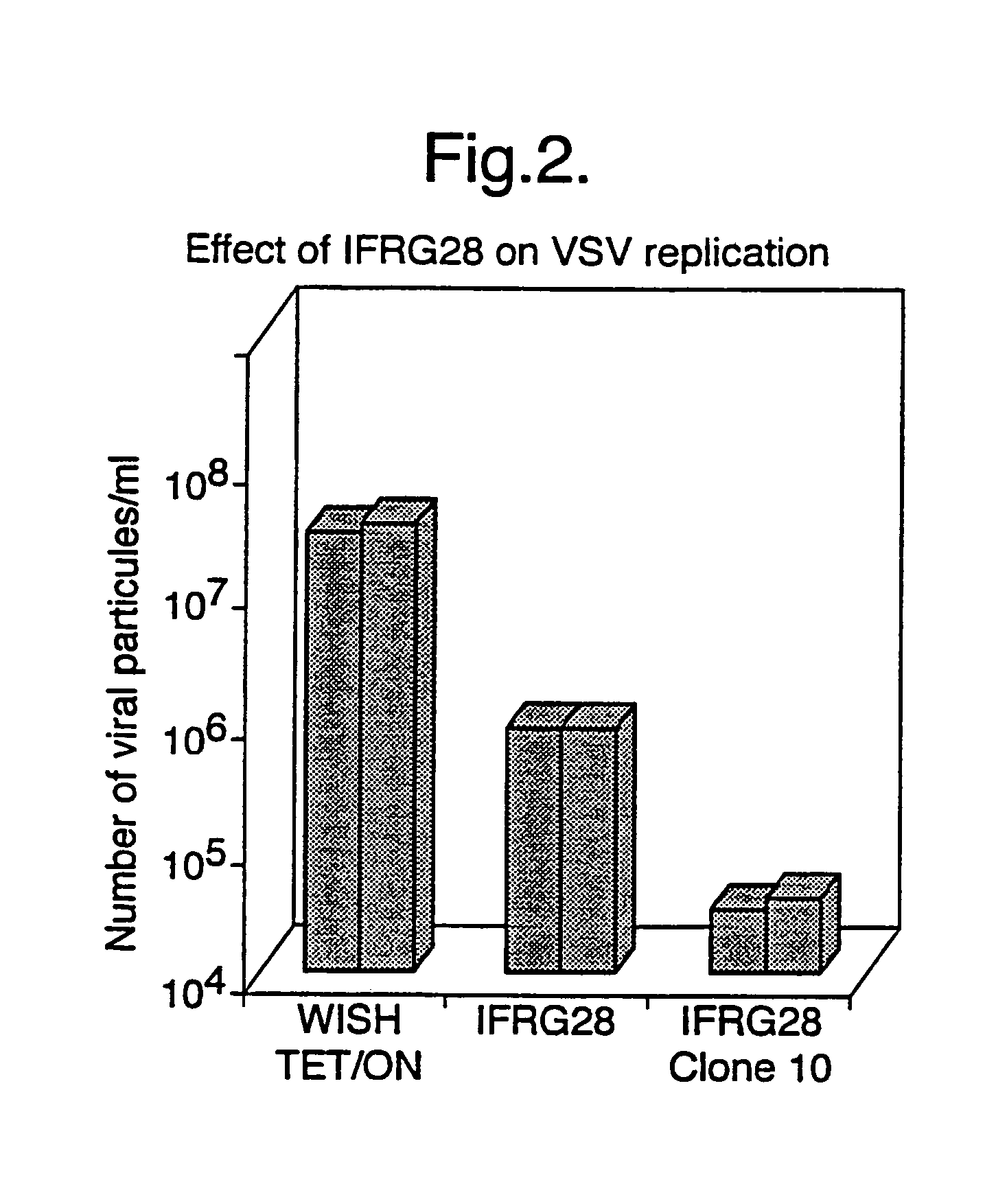Interferon alpha responsive protein
a technology of interferon alpha and responsive protein, which is applied in the field of interferon alpha responsive protein, can solve the problems of inability of physicians to confidently predict, the fraction of those who respond to long-term benefits, and the cost-benefit ratio
- Summary
- Abstract
- Description
- Claims
- Application Information
AI Technical Summary
Benefits of technology
Problems solved by technology
Method used
Image
Examples
example 1
[0095]Previous experiments had shown that the application of 5 μl of crystal violet to each nostril of a normal adult mouse using a P20 Eppendorf micropipette resulted in an almost immediate distribution of the dye over the whole surface of the oropharyngeal cavity. Staining of the oropharyngeal cavity was still apparent some 30 minutes after application of the dye. These results were confirmed by using 125I-labelled recombinant human IFN-α1–8 applied in the same manner. The same method of administration was employed to effect oromucosal administration in the studies which are described below.
[0096]Six week old, male DBA / 2 mice were treated with either 100,000 IU of recombinant murine interferon α (IFN α) purchased from Life Technologies Inc. in phosphate buffered saline (PBS), 10 μg of recombinant human interleukin 15 (IL-15) purchased from Protein Institute Inc, PBS containing 100 μg / ml of bovine serum albumin (BSA), or left untreated. Eight hours later, the mice were sacrificed b...
example 2
Intravenous Administration of IFN-α
[0101]Male DBA / 2 mice were injected intravenously with 100,000 IU of recombinant murine IFN-α purchased from Life Technologies Inc. in 200 μl of PBS or treated with an equal volume of PBS alone. Eight hours later, the animals were sacrificed by cervical dislocation and the spleen was removed using conventional procedures. Total RNA was extracted by the method of Chomczynski and Sacchi (Anal. Biochem. (1987) 162, 156–159) and 10.0 μg of total RNA per sample was subjected to Northern blotting in the presence of glyoxal and hybridised with a cDNA probe for HuIFRG28-1 mRNA as described by Dandoy-Dron et al. (J. Biol. Chem. (1998) 273, 7691–7697). The blots were first exposed to autoradiography and then quantified using a PhosphoImager according to the manufacturer's instructions. Enhanced levels of mRNA for HuIFRG28-1 protein (approximately 5 to 10 fold) were detected in samples of RNA extracted from spleens of IFN-α treated animals relative to animals...
example 3
Testing Type 1 Interferon Responsiveness in Vitro
[0102]Human peripheral blood mononuclear cells (PBMCs) from normal donors were isolated on Ficoll-Hypaque density gradients and treated in vitro with 10,000 IU of recombinant human IFN-α2 (Intron A from Schering-Plough) in PBS or with an equal volume of PBS alone. Eight hours later the cells were centrifuged (800×g for 10 minutes) and the cell pellet recovered. Total RNA was extracted from the cell pellet by the method of Chomczynski and Sacchi and 10.0 μg of total RNA per sample was subjected to Northern blotting in the presence of glyoxal and hybridised with a cDNA probe for HuIFRG28-1 mRNA as previously described in Example 2 above. Enhanced levels of mRNA for HUIFRG28-1 protein (approximately 10-fold) were detected in samples of RNA extracted from IFN-α treated PBMCs compared to samples treated with PBS alone.
[0103]The same procedure may be used to predict Type 1 interferon responsiveness using PBMCs taken from a patient proposed ...
PUM
| Property | Measurement | Unit |
|---|---|---|
| volume | aaaaa | aaaaa |
| drug-resistance | aaaaa | aaaaa |
| resistance | aaaaa | aaaaa |
Abstract
Description
Claims
Application Information
 Login to View More
Login to View More - R&D
- Intellectual Property
- Life Sciences
- Materials
- Tech Scout
- Unparalleled Data Quality
- Higher Quality Content
- 60% Fewer Hallucinations
Browse by: Latest US Patents, China's latest patents, Technical Efficacy Thesaurus, Application Domain, Technology Topic, Popular Technical Reports.
© 2025 PatSnap. All rights reserved.Legal|Privacy policy|Modern Slavery Act Transparency Statement|Sitemap|About US| Contact US: help@patsnap.com


